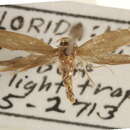Comprehensive Description
provided by Smithsonian Contributions to Zoology
Opogona floridensis
ADULT (Figure 4).—Moderately small, with slender, almost entirely stramineous forewings, bearing a single, very small fuscous spot midway along hind wings.
Wing Expanse: , 15–16 mm.
Head: Vestiture generally smooth and predominantly stramineous except for dark fuscous scaling posterior to antennae and frontal tuft; scales of vertex between antennae stramineous and typically raised to form a low, rounded ridgelike tuft that slightly extends over upper portion of frons; frons smooth, scales closely appressed. Antennae approximately 0.7 length of forewing, 80–93 segmented; scape stramineous above, heavily suffused with dark fuscous beneath, slightly flattened and concave ventrally; flagellum uniformly stramineous with one row of relatively slender scales per segment. Maxillary palpi stramineous, densely pubescent ventrally. Labial palpi mostly stramineous dorsally with a strong suffusion of dark fuscous ventrally, especially on apical segment.
Thorax: Pronotum stramineous; meso- and metanota naked; tegulae stramineous above, dark fuscous along costal margin and beneath. Venter whitish to pale stramineous. Prolegs stramineous to whitish ventrally, mostly dark fuscous above; mesothoracic legs similarly colored but with fuscous scaling above more faded and suffused; metathoracic legs mostly pale stramineous with slight suffusion of brownish fuscous over dorsum of tarsi. Forewings entirely stramineous except for dark fuscous scaling along basal fifth of costal margin and a small, faint fuscous spot midway along hind margin; fringe stramineous; ventral surface mostly brownish fuscous. Hind wings pale gray with stramineous fringe above and below, more thinly scaled than forewings.
Abdomen: Stramineous above; pale, more whitish ventrally.
Male Genitalia (Figures 115–118): Uncus deeply divided into two large, widely separated lobes bearing numerous elongate setae on their mesal surfaces. Tegumen moderately developed into a relatively broad ring dorsally. Vinculum relatively well developed, narrowing gradually to saccus which, together with vinculum, forms a broad V-shaped sclerite ventrally. Valvae prominently divided into two rounded lobes consisting of an extension of the costal margin and the cucullus; valvae without cluster of stout setae but with slender hairlike setae. Anellus forming a slightly sclerotized ring encircling aedeagus. Aedeagus simple, slightly curved beyond middle, and without cornuti.
HOLOTYPE.—, 24 Dec 1964, Miami, Fla., ex light trap, USDA lot 65–56, genitalia slide USNM 18420, USNM type 72094: in the National Museum of Natural History, Smithsonian Institution.
PARATYPE.—UNITED STATES. FLORIDA: Dade Co: Miami: 1 , 24 Dec 1964, coll. J. C. Buff, ex light trap, USDA lot 65–56, genitalia slide USNM 18426 (USNM); 1 , 21 Dec 1964, coll. J. C. Buff, caught in black light trap in Miami Inspection Sta, USDA lot 65–2713 (USNM). Described from a total of 3 males.
HOST.—Unknown.
FLIGHT PERIOD.—December.
DISTRIBUTON (Map 1).—Presently known only from the type-locality, which is located in the Atlantic Coastal Plain of extreme southern Florida.
- bibliographic citation
- Davis, Donald R. 1978. "The North American Moths of the General Phaeoses, Opogona, and Oinophila, with a Discussion of their Supergeneric Affinities (Lepidoptera: Tineidae)." Smithsonian Contributions to Zoology. 1-39. https://doi.org/10.5479/si.00810282.282

